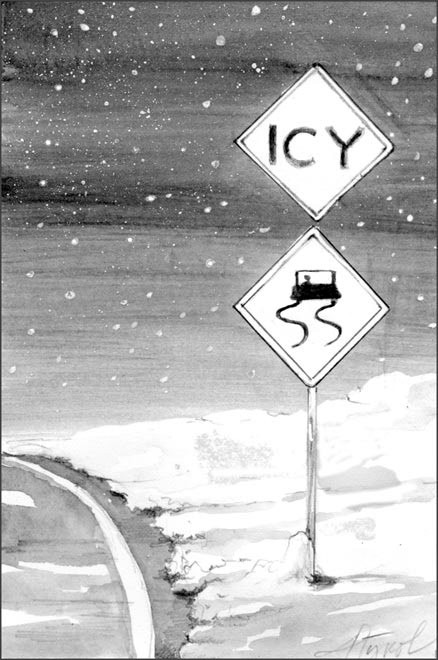
Spreading salt to make treacherous ice disappear must have seemed brilliant in the early days of its use. Naturally occurring, abundant, and cheap, road salt allows people to get to work on time and to get home again, even when slippery snow or sleet pelts through the total darkness of a typical winter evening commute.
But the price of this peace of mind turns out to be high when everything is counted. Rusted out cars, corroded bridges, weakened parking garages, contaminated wells and streams, and a lot of sick roadside vegetation are among the many costs of a safer ride.
The best news on the road salt front in this area is the increasing use of salt brine instead of dry salt. Gil Newbury of the Vermont Agency of Transportation compares it to the non-stick stuff you spray on a frying pan. Applied just before a storm begins, it keeps snow from sticking to the road, making it easy for plows to wing it off the roadbed. It’s estimated that up to one-third of the dry salt that leaves a spreader bounces right into the roadside ditch before doing any melting at all, whereas brine stays put. Like any salt, it becomes less effective as the temperature drops, but the addition of molasses – yes, molasses – makes the brine work when it’s nearly -4°F, while salt alone loses almost all of its melting power at around 15°F.
Fifty or so years of enthusiastic salt use has taught us a lot, and vehicles and highways are now built to resist salt, at least to some extent. Cars are made of more rust-resistant materials, reinforcing in concrete bridge decks is epoxy coated, and there are better paints for steel bridges. Though woody roadside vegetation cannot be modified so simply, it turns out that some species have considerably more resistance to salt than others. (Black ash, cottonwood, tamarack, northern red oak, balsam poplar, gray dogwood, staghorn sumac, choke cherry, and serviceberry are all highly tolerant.)
Unfortunately, this list does not include many of our most common trees; sugar maple, beech, and white pine are among the worst choices for salty roadsides. And, alas, some of those aggressive non-native species that we love to hate do rather well in brine: non-native honeysuckles, autumn olive, common buckthorn, and Norway maple.
Salt enters trees and shrubs either by being splashed onto the above-ground parts or by way of the roots. Curiously, plants that resist salt at one entry point may be highly vulnerable at the other. Northern red oak is a champ at keeping soil-borne salt out, but the leaves of seaside oaks splashed with salt spray by hurricanes turn brown within a few days.
In solution, salt separates into sodium and chloride ions and it’s the chloride ones that cause more damage to plants at the cellular level. Salt tolerance is based more on a plant’s ability to exclude chloride than on any intrinsic ability to tolerate it. Severely damaged plants may have chloride levels of 1.25 to 2 percent. Tolerant species growing under the same conditions will have levels of 0.5 to 0.9 percent.
Though sodium ions enter plant tissues more slowly, they are the major culprits in soil compaction – yet another method that salt uses to kill vegetation. Sodium ions change the way that soil particles aggregate, leading to a loss of normal spatial distribution. Severely compacted soil restricts access to water and oxygen, and the symptoms resemble those caused by drought. Plus, sodium travels along the same shuttle system as potassium and magnesium – both essential to making chlorophyll – and if excess sodium messes up the system, potassium deficiency results.
The amount of salt used to melt last winter’s near-record 122.8 inches of snow on state roads in Vermont was 37 percent less than in the similarly snowy winter of 2000-2001. Plus, last year, the state used almost no sand, which meant almost no hydrocarbon-soaked sand clogs in our stream beds. New Hampshire, too, is dissolving salt before applying it to the road. From a tree’s perspective, this trend is overwhelmingly positive.
Road salt in some form is here to stay, at least until global warming takes a giant leap forward. There’s no future in asking drivers to slow down, stay home, or risk sliding into each other just in order to keep white pines from turning brown. Although the harm to the environment does keep building decade after decade, we’re pretty much stuck with trying to slow the rate of increase in the damage inflicted.


Discussion *